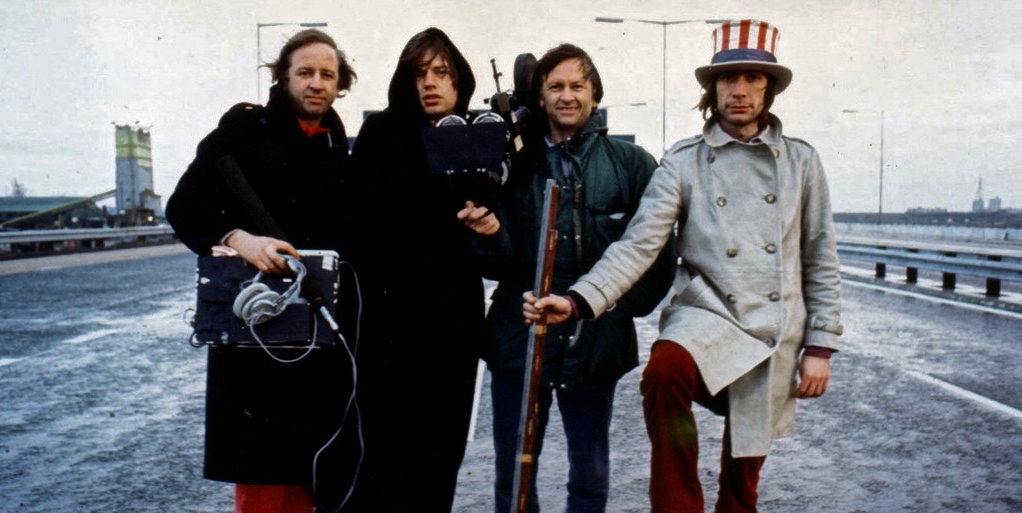
08 Aug Rock & Roll on Film, Part the Second + Matador Playlist 7/5/18
In late 1969 the Rolling Stones were touring the United States for the first time in three years, having suffered through a variety of legal hassles and harassment at home and the departure and subsequent death of the group’s onetime leader and guitarist, Brian Jones (replaced by the young virtuoso Mick Taylor). A lot had changed a lot since 1964 and the T.A.M.I. Show and Mick’s lack of formal neckwear didn’t seem quite as scandalous. The band had decided it was time to bust a cinematic move and they hired the Maysles Brothers—Albert and David—and Charlotte Zwerin, to film and direct a document of the tour in which the Stones presented their bonafides as ‘the Greatest Rock n’ Roll Band in the World.’
 By the time ‘Gimme Shelter’ was released in December, 1970, everybody knew perfectly well what had transpired at the tour-ending free concert in Altamont, California. The film starts setting up the horror from the very beginning with scenes of Jagger and Charlie Watts in an editing suite looking at film clips and listening to recordings of radio broadcasts from just after the concert. Sonny Barger of the San Francisco Hell’s Angels, calling into a radio show, deflects all the blame for the Altamont disaster onto drugged up hippies and the Stones. Mick looks perplexed, Charlie mutters ‘What a shame.’ A shame it was indeed and ‘Gimme Shelter’ looks it directly in the face, recording everything with a disconcertingly unflinching eye. The movie ricochets from one locale to another, jumping to Mick and Charlie back in England on a photo shoot for the cover of ‘Get Your YaYa’s Out.’ Next, the Stones are bopping around in an Alabama motel room (with journalist Stanley Booth), hanging out backstage at Madison Square Garden, crammed into a small control room at Muscle Shoals Sound listening to mixes for ‘Sticky Fingers.’ Everyone looks zoned out. Charlie gets into a staring contest with the camera. The scene bounces from riveting stage footage at Madison Square Garden to lawyer Melvin Belli’s office in San Francisco as he negotiates to find a last-second venue for the free concert. The energy and momentum build and for a few moments the mood seems somewhat upbeat.
By the time ‘Gimme Shelter’ was released in December, 1970, everybody knew perfectly well what had transpired at the tour-ending free concert in Altamont, California. The film starts setting up the horror from the very beginning with scenes of Jagger and Charlie Watts in an editing suite looking at film clips and listening to recordings of radio broadcasts from just after the concert. Sonny Barger of the San Francisco Hell’s Angels, calling into a radio show, deflects all the blame for the Altamont disaster onto drugged up hippies and the Stones. Mick looks perplexed, Charlie mutters ‘What a shame.’ A shame it was indeed and ‘Gimme Shelter’ looks it directly in the face, recording everything with a disconcertingly unflinching eye. The movie ricochets from one locale to another, jumping to Mick and Charlie back in England on a photo shoot for the cover of ‘Get Your YaYa’s Out.’ Next, the Stones are bopping around in an Alabama motel room (with journalist Stanley Booth), hanging out backstage at Madison Square Garden, crammed into a small control room at Muscle Shoals Sound listening to mixes for ‘Sticky Fingers.’ Everyone looks zoned out. Charlie gets into a staring contest with the camera. The scene bounces from riveting stage footage at Madison Square Garden to lawyer Melvin Belli’s office in San Francisco as he negotiates to find a last-second venue for the free concert. The energy and momentum build and for a few moments the mood seems somewhat upbeat.
About half way through the film shifts its focus fully to Altamont and things start going wrong almost immediately. A wigged out hippie kid punches Mick in the face as the band makes its way from their helicopter to a trailer behind the stage. The whole scene seems irrevocably off, somehow. No one is in control and people are getting very fucked up very quickly. The Woodstock wannabe vibe is turning inside out and cannibalizing itself in a twisted and ugly way. A white woman wanders through the throng soliciting contributions for a Black Panther defense fund, pointing out, helpfully, that ‘They’re just Negroes, you know.’
Petty turf disputes erupt around the stage. Too many fucked up people and too little empathy. The Hell’s Angels start wading into the crowd with violent zeal, weighted pool cues swinging. It’s a nightmare, steadily building as darkness falls, and everybody seems powerless to stop it. Mike Shrieve of Santana’s band tells Phil Lesh and Jerry Garcia that the Hell’s Angels have beaten up Marty Balin of the Jefferson Airplane—‘It’s really weird, man.’ Lesh is incredulous: ‘Angels are beating up musicians? It doesn’t seem right.’ Nothing seems right. The Dead ultimately declined to perform.
 The terrified looks on people’s faces are terrifying. After the Stones take the stage and the mayhem builds Keith is the only one who refuses to back down, calling out individual Angels for their excesses. Some random raggedy guy in the throes of acid horrors is standing a few feet from Mick during ‘Under My Thumb’ before a couple of Angels violently throw him off the stage. Meredith Hunter pulls a pistol and gets stabbed to death by an Angel in full view of the stage and the cameras.
The terrified looks on people’s faces are terrifying. After the Stones take the stage and the mayhem builds Keith is the only one who refuses to back down, calling out individual Angels for their excesses. Some random raggedy guy in the throes of acid horrors is standing a few feet from Mick during ‘Under My Thumb’ before a couple of Angels violently throw him off the stage. Meredith Hunter pulls a pistol and gets stabbed to death by an Angel in full view of the stage and the cameras.
Mick watches the murder footage in slo mo in the editing suite. A nightmare on film. He gets up to leave and the camera catches him, freezes and zooms in on his face. What does that look mean? Is it an indictment? A vindication? Like ‘Blow-Up,’ ‘Gimme Shelter’ concerns a murder inadvertently caught on film. Like ‘Blow-Up,’ the film offers no answers. It’s up to us to figure it out. What the fuck happened here and who is responsible? The various parties involved have been dancing around the issue ever since. ‘Gimme Shelter’ is a beautiful, horrifying film and it’s all real. This is why it is probably the greatest rock and roll movie ever made.
There are three more films of note that concern the Rolling Stones: ‘The Rolling Stones Rock n’ Roll Circus,’ 1968, ‘Performance,’ 1968-‘70, and ‘Cocksucker Blues,’ 1972. All three films were deemed to be radioactive for one reason or another and were shelved for years and even decades. One of them has never been released to general audiences and probably never will be.
‘Rock n’ Roll Circus’ is somewhat like an avant/decadent update of the T.A.M.I. Show concept, just four years on but a world away in more ways than one. It’s a grab bag concert of current rock and roll royalty and up-and-comers, conceived of and performed for the cameras in front of a small invited audience in a London television studio. The line up is exceptional: Jethro Tull (with the young Tommy Iommi on guitar), Marianne Faithfull, Taj Mahal (with the young Jesse Ed Davis on guitar), the Who, the Rolling Stones, and a one-off supergroup featuring John Lennon, Yoko Ono, Mitch Mitchell, Keith Richards and Eric Clapton. Shot over the course of one very long afternoon and evening in December, 1968, the film was intended to be broadcast on television the following year but ‘twas not to be.
 ‘Rock n’ Roll Circus’ is notable for several things, the first and foremost being the powerhouse performance by The Who. Unlike the Stones, who had not performed live in months, the Who had been touring constantly and were in tip top form, to a man. Pete Townshend had assembled his first extended composition, ‘A Quick One While He’s Away,’ for the band’s second album ‘A Quick One,’ and the song contained the seeds that were to grow into their fullness in ‘Tommy,’ released the following May. Their performance of ‘A Quick One While He’s Away’ is, quite simply, the greatest, most exuberant seven minutes and forty seconds of rock and roll ever committed to film. Townshend leaps and windmills like a madman, Daltrey is in fine voice and twirls his mic with exceptional precision, Entwistle is as virtuosic and stoic as ever, and Keith Moon… well, you just have to see it to believe it. It’s hard to fathom how a group could play with such wild physical abandon and yet sound so great. This is rock and roll.
‘Rock n’ Roll Circus’ is notable for several things, the first and foremost being the powerhouse performance by The Who. Unlike the Stones, who had not performed live in months, the Who had been touring constantly and were in tip top form, to a man. Pete Townshend had assembled his first extended composition, ‘A Quick One While He’s Away,’ for the band’s second album ‘A Quick One,’ and the song contained the seeds that were to grow into their fullness in ‘Tommy,’ released the following May. Their performance of ‘A Quick One While He’s Away’ is, quite simply, the greatest, most exuberant seven minutes and forty seconds of rock and roll ever committed to film. Townshend leaps and windmills like a madman, Daltrey is in fine voice and twirls his mic with exceptional precision, Entwistle is as virtuosic and stoic as ever, and Keith Moon… well, you just have to see it to believe it. It’s hard to fathom how a group could play with such wild physical abandon and yet sound so great. This is rock and roll.
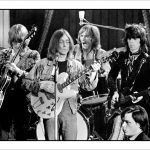 The penultimate performance is the supergroup, dubbed the Dirty Mac: Lennon on rhythm guitar and vocals, Keith on bass, Mitch Mitchell on drums, Eric Clapton playing lead. They rip through a fantastic version of Lennon’s ‘Yer Blues’ from the Beatles ‘White Album’ and then launch into a bluesy three-chord vamp. Yoko climbs inside of a black bag at the foot of the stage and rolls about, yowling like a dying cat. Classical violinist Ivry Gitlis saws away determinedly while struggling to maintain a straight face. It’s all good, clean fun.
The penultimate performance is the supergroup, dubbed the Dirty Mac: Lennon on rhythm guitar and vocals, Keith on bass, Mitch Mitchell on drums, Eric Clapton playing lead. They rip through a fantastic version of Lennon’s ‘Yer Blues’ from the Beatles ‘White Album’ and then launch into a bluesy three-chord vamp. Yoko climbs inside of a black bag at the foot of the stage and rolls about, yowling like a dying cat. Classical violinist Ivry Gitlis saws away determinedly while struggling to maintain a straight face. It’s all good, clean fun.
Then it’s time for the Stones set and it’s pretty obvious from the git go that they’re not firing on all cylinders. Brian Jones is barely there—it’s like he’s beginning to evaporate into a blonde, druggy vapor before our very eyes—and portions of his performance are inaudible. For ‘Sympathy for the Devil’ he plays maracas instead of guitar. It was to be Jones’s last public performance—he was found dead in his swimming pool less than seven months later. Compared to the performances by the Dirty Mac and especially the Who, the Stones seem flat and uninspired. Jagger’s performance is overly mannered and since both audience and band were exhausted by this point he’s playing to some kind of tension that’s simply not there. Jagger was predictably unhappy with the resulting film and it was shelved for the next 28 years. The only portion of the ‘Rock n’ Roll Circus’ that saw daylight in between was the Who’s now-legendary segment, which was tantalizingly included in the band’s 1979 documentary film ‘The Kids Are Alright.’
The next exhibit in the Rolling Stones-centric pantheon of cinematic greatness is ‘Performance,’ a 1968 film directed by Donald Cammell and Nicolas Roeg. It’s instructive to consider this film alongside ‘Blow-Up.’ Except for the opening segment of ‘Blow-Up’ in which Thomas emerges from spending the night in a doss house, ‘Blow-Up’ is all shiny surfaces, bright colors and pretty people (even if some of them are zombies). ‘Performance’ presents another aspect of London altogether: crumbling old homes, garbage filled inner city squares, industrial zones, grim railway stations, seedy clubs, porn theaters, garages and betting shops. And gangsters. Lots of gangsters.
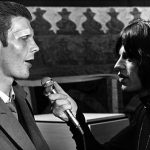 Chas, played by the great James Fox, is one of those gangsters. Younger and prettier than his cohorts, he is his boss Harry Flowers’ star ‘performer.’ Chas is compulsively neat and hyper-masculine but his carefully curated persona provides cover for sadomasochist tendencies and vague homoerotic undercurrents. Chas applies the strong arm to Harry’s rivals with a bit too much gusto for his boss, who aspires to the appearance, if not the reality, of legitimate business: ‘mergers and acquisition’ with a bit of Piranha Brothers-style persuasion. When Chas gets a taste of his own medicine (with the apparent blessing of Harry Flowers) he murders a rival and ends up on the run. Taking on the persona of a red-haired vaudevillian/villain, Chas ends up hiding out in a basement apartment in a ramshackle Victorian mansion owned by Turner (Mick Jagger).
Chas, played by the great James Fox, is one of those gangsters. Younger and prettier than his cohorts, he is his boss Harry Flowers’ star ‘performer.’ Chas is compulsively neat and hyper-masculine but his carefully curated persona provides cover for sadomasochist tendencies and vague homoerotic undercurrents. Chas applies the strong arm to Harry’s rivals with a bit too much gusto for his boss, who aspires to the appearance, if not the reality, of legitimate business: ‘mergers and acquisition’ with a bit of Piranha Brothers-style persuasion. When Chas gets a taste of his own medicine (with the apparent blessing of Harry Flowers) he murders a rival and ends up on the run. Taking on the persona of a red-haired vaudevillian/villain, Chas ends up hiding out in a basement apartment in a ramshackle Victorian mansion owned by Turner (Mick Jagger).
 Turner is an androgynous rock star, oddly reminiscent of, well… Mick Jagger. Having lost touch with his muse, Turner retreats into Borges-reading seclusion, shacked up in louche splendor with Pherber (Anita Pallenberg—Brian Jones’s former gal, Keith Richards’ current) and the pixieish Lucy (Michelle Breton). When the tightly-wound, macho Chas drops into their midst Turner and his mini-harem set about deconstructing his psyche with liberal doses of hallucinogenic mushrooms, mysticism and sex. All the while, Harry Flowers’ boys circle steadily, eventually tracking Chas to Turner’s lair.
Turner is an androgynous rock star, oddly reminiscent of, well… Mick Jagger. Having lost touch with his muse, Turner retreats into Borges-reading seclusion, shacked up in louche splendor with Pherber (Anita Pallenberg—Brian Jones’s former gal, Keith Richards’ current) and the pixieish Lucy (Michelle Breton). When the tightly-wound, macho Chas drops into their midst Turner and his mini-harem set about deconstructing his psyche with liberal doses of hallucinogenic mushrooms, mysticism and sex. All the while, Harry Flowers’ boys circle steadily, eventually tracking Chas to Turner’s lair.
‘Performance’ is a movie that you either love or hate. I love this film. Yes, it’s rather pretentious and the premise of personality/gender fluidity is a bit vague, but when I saw this film as a kid I felt like I my personality and gender had been rearranged a bit. It’s Jagger’s best role as an actor (perhaps because he’s more or less playing himself) and there’s a musical interlude where Chas and Turner’s characters meld as Jagger performs the Stones song ‘Memo From Turner.’ This is sort of a ‘trip’ film and despite being philosophically dense it’s extraordinarily rich and inventive visually. And speaking of visuals, you get a very full appreciation of why Anita Pallenberg is considered one of the great beauties of the ‘60s.
The suits at Warner Brothers apparently weren’t aware of what they were getting themselves into with ‘Performance.’ The film is fairly risqué, perhaps even more so by contemporary standards, and the studio shelved the project for two years before reediting and releasing it. ‘Performance’ has enjoyed a highly positive critical reassessment over the years and is now considered a cult classic. It has proven to be highly influential, not the least for its groundbreaking portrayal of the London mob world (the film contains the first recorded use of the phrase ‘Jack the Lad’). Most importantly, ‘Performance’ launched the career of Nic Roeg. Between 1970 and 1980, Roeg went on to direct ‘Walkabout,’ ’Don’t Look Now,’ ’The Man Who Fell to Earth,’ and ‘Bad Timing,’—four of the greatest films of the era.
Whether you consider the Beatles or the Rolling Stones the greater group, there’s no denying that the Stones have left a much more ambitious cinematic legacy. The Beatles are primarily associated with director Richard Lester, while the Stones aligned themselves with the Maysles Brothers, Nic Roeg, Jean-Luc Godard (‘Sympathy for the Devil: 1+1,’ —an interesting but ultimately unbearable bit of Marxist propaganda), and—finally—Robert Frank. Yes, that Robert Frank—the legendary Swiss/American photographer, author of the classic 1958 book ‘The Americans‘ and director of the famously scandalous ‘Cocksucker Blues.‘
 By 1972 Frank had several films to his credit (including his second best-known effort, the Beat-scene short ‘Pull My Daisy,’ 1959) but he was a decidedly unusual choice for a rock and roll tour documentary. The ’72 summer tour marked the Stones’ first American shows since the Altamont debacle and a lot was at stake. The band was promoting ‘Exile on Main Street’ (for which Robert Frank had contributed album cover photography) and with the Beatles now relegated to the history books the Stones were looking to solidify their billing as Greatest Rock n’ Roll Band in the World. Frank and his camera were granted unlimited access, back and front of house, and additional cameras were made available to the touring entourage to use at their discretion (although ‘discretion’ seems to have had little to do with it). The resulting document contrasts the energy and excitement of the concerts with the tedium of life on the road and the excesses employed to stave off that tedium. No documentary film before or since has ever come close to portraying sex, drugs and rock and roll in a manner quite as raw and unembellished as this.
By 1972 Frank had several films to his credit (including his second best-known effort, the Beat-scene short ‘Pull My Daisy,’ 1959) but he was a decidedly unusual choice for a rock and roll tour documentary. The ’72 summer tour marked the Stones’ first American shows since the Altamont debacle and a lot was at stake. The band was promoting ‘Exile on Main Street’ (for which Robert Frank had contributed album cover photography) and with the Beatles now relegated to the history books the Stones were looking to solidify their billing as Greatest Rock n’ Roll Band in the World. Frank and his camera were granted unlimited access, back and front of house, and additional cameras were made available to the touring entourage to use at their discretion (although ‘discretion’ seems to have had little to do with it). The resulting document contrasts the energy and excitement of the concerts with the tedium of life on the road and the excesses employed to stave off that tedium. No documentary film before or since has ever come close to portraying sex, drugs and rock and roll in a manner quite as raw and unembellished as this.
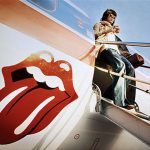 Alternating between grainy black and white and color footage in a sort of Kansas/Oz juxtaposition (only the stage performances are consistently in color), ‘Cocksucker Blues’ is all shaky handheld camera work, edited with jump cuts, collage effects and few, if any, concessions to any linear narrative. There is extensive and explicit needle play, coke snorting, dope smoking, pill popping and groupie sex. Terry Southern, Lee Radziwill, Truman Capote, Andy Warhol, Ahmet Ertegun, Bianca Jagger, Dick Cavett, Stevie Wonder, and Tina Turner all wander in and out of dressing rooms and hotel suites.The Stones cruise a southern highway in a station wagon, stopping to drink and shoot pool in a saloon. Mick Taylor actually smiles (!!) when the Stones jam with Stevie Wonder’s band on ‘Uptight’ and ‘Satisfaction.’ Keith, on the smack nods, slumps slo mo into the lap of some random needle groupie backstage while Mick chats with Ahmet Ertegun in an adjacent room. Black and white footage of Mick and Keith sitting side by side on a bed in a hotel room listening to an acetate of ‘Happy’ merges into color footage of the two of them singing the song together onstage. Keith and saxophonist Bobby Keys obligingly throw a television set off of a hotel balcony for Frank’s camera. Not quite all good, clean fun.
Alternating between grainy black and white and color footage in a sort of Kansas/Oz juxtaposition (only the stage performances are consistently in color), ‘Cocksucker Blues’ is all shaky handheld camera work, edited with jump cuts, collage effects and few, if any, concessions to any linear narrative. There is extensive and explicit needle play, coke snorting, dope smoking, pill popping and groupie sex. Terry Southern, Lee Radziwill, Truman Capote, Andy Warhol, Ahmet Ertegun, Bianca Jagger, Dick Cavett, Stevie Wonder, and Tina Turner all wander in and out of dressing rooms and hotel suites.The Stones cruise a southern highway in a station wagon, stopping to drink and shoot pool in a saloon. Mick Taylor actually smiles (!!) when the Stones jam with Stevie Wonder’s band on ‘Uptight’ and ‘Satisfaction.’ Keith, on the smack nods, slumps slo mo into the lap of some random needle groupie backstage while Mick chats with Ahmet Ertegun in an adjacent room. Black and white footage of Mick and Keith sitting side by side on a bed in a hotel room listening to an acetate of ‘Happy’ merges into color footage of the two of them singing the song together onstage. Keith and saxophonist Bobby Keys obligingly throw a television set off of a hotel balcony for Frank’s camera. Not quite all good, clean fun.
‘Cocksucker Blues’ is a disconcerting, anarchic clash and hash of images, sounds, music, chaos and boredom. The movie is so real that it seems surreal—difficult to watch at times but somehow weirdly beautiful in the end. It’s almost unbelievable that the film ever got made in the first place, but once made it quickly became apparent to Jagger & Co. that it could never be released. Realizing that they had cinematic plutonium on their hands, the Stones came to an agreement with Frank that the film could be screened only if the filmmaker himself was present. I happened to be in New York on one such occasion in the early 1990s and saw the film on the big screen at the Anthology Film Archives. I think my brain was scrambled for a week. Should the opportunity to have your brain similarly scrambled ever come your way I suggest you take it without hesitation. Robert Frank is now 93 years old and after he’s gone who knows what fate will befall this notorious and mythic document.
The 1970s saw a surge in rock-related cinema, of both the documentary and dramatic varieties. Some of these offerings are excellent, some are worthy of viewing (once) and others are moronic garbage. In the first category are excellent films such as ‘Easy Rider,’ 1969 and ‘Two Lane Blacktop,’ 1971: Films not specifically about music, as such, but with very much of a rock & roll vibe. Everybody knows ‘Easy Rider,’ or should know, so if you don’t know you have no one but yourself to blame. ‘Two Lane Blacktop,’ an existential road trip film starring James Taylor and Dennis Wilson of the Beach Boys, is all about cars but claims a rock n’ roll pedigree nonetheless thanks to its cast. It’s a rather frustrating film but it has held up well over the years and is now considered a minor classic.
 A couple of prime contenders in the ‘moronic garbage’ genre are Brian de Palma’s dreadful ‘Phantom of the Paradise,’ 1974, and Ken Russell’s bloated interpretation of the Who’s ‘Tommy,’ 1975. No film that aspires to any shred of rock & roll credibility can possibly star Paul Williams, so little more need be said of ‘Phantom of the Paradise,’ other than 44 years on it’s just vaguely possible that it might have accrued some trash/camp appeal. On second thought, no—it’s not vaguely possible. ‘Tommy’ has its admirers, I know, but as a devoted fan of the Who and the original album—an unalloyed masterpiece for the ages—Ken Russell’s film is a gaudy, ham-fisted piece of crap. Forgot the crappy movie, forget the crappy all-star soundtrack album. Listen to the original and all shall be revealed.
A couple of prime contenders in the ‘moronic garbage’ genre are Brian de Palma’s dreadful ‘Phantom of the Paradise,’ 1974, and Ken Russell’s bloated interpretation of the Who’s ‘Tommy,’ 1975. No film that aspires to any shred of rock & roll credibility can possibly star Paul Williams, so little more need be said of ‘Phantom of the Paradise,’ other than 44 years on it’s just vaguely possible that it might have accrued some trash/camp appeal. On second thought, no—it’s not vaguely possible. ‘Tommy’ has its admirers, I know, but as a devoted fan of the Who and the original album—an unalloyed masterpiece for the ages—Ken Russell’s film is a gaudy, ham-fisted piece of crap. Forgot the crappy movie, forget the crappy all-star soundtrack album. Listen to the original and all shall be revealed.
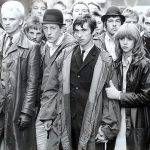 The Who’s legacy received a much more sympathetic cinematic treatment in 1979 with ‘Quadrophenia.’ Blessed with a more cohesive narrative than ‘Tommy’ and a grounding in the style-obsessed Mod movement, ‘Quadrophenia’ was well suited for the big screen treatment. It’s not quite a great film but it’s better than average and made a good pairing with the Who documentary ‘The Kids Are Alright,’ released earlier the same year. Sadly, the Who’s legacy contains no equivalent to ‘A Hard Day’s Night,’ ‘Gimme Shelter’ or even ‘Blow-Up’ (although the Who were originally slotted for the nightclub sequence that ended up going to the Yardbirds). The band’s segment in the ‘Rock n’ Roll Circus’ will just have to suffice.
The Who’s legacy received a much more sympathetic cinematic treatment in 1979 with ‘Quadrophenia.’ Blessed with a more cohesive narrative than ‘Tommy’ and a grounding in the style-obsessed Mod movement, ‘Quadrophenia’ was well suited for the big screen treatment. It’s not quite a great film but it’s better than average and made a good pairing with the Who documentary ‘The Kids Are Alright,’ released earlier the same year. Sadly, the Who’s legacy contains no equivalent to ‘A Hard Day’s Night,’ ‘Gimme Shelter’ or even ‘Blow-Up’ (although the Who were originally slotted for the nightclub sequence that ended up going to the Yardbirds). The band’s segment in the ‘Rock n’ Roll Circus’ will just have to suffice.
An early and worthy entry in the biographical documentary category is ‘A Film About Jimi Hendrix,’ 1973. This is one of the first such rock artist bios and it helped set the template for many subsequent efforts: Archival performance sequences interspersed with interviews with the artist, band members, friends and associates. It’s a nicely paced film and paints a sympathetic portrait of a complex and elusive subject. ‘A Film About Jimi Hendrix’ offers an antidote to ‘Rainbow Bridge,’ 1971—an incomprehensible goulash of hippie gobbledegook that, almost coincidentally, features a performance by Jimi Hendrix in a volcanic crater in Hawaii. This film is embarrassingly awful, but the soundtrack album was surprisingly good. Odd, that. There have been a couple of dramatic biographical films made about Jimi Hendrix, but the less said about them the better.
 Led Zeppelin weighed into the concert film sweepstakes in 1976 with the moderately dreadful ‘The Song Remains the Same.’ Zeppelin could be a killer live band so it’s rather baffling as to how they came to release a movie based around such a lackluster performance. The movie has been influential, though perhaps not in the way Zeppelin intended: You can draw a direct line from the conceit of the fantasy sequence for each band member to ‘Spinal Tap.’ Jimmy Page’s cinematic heyday will have to remain his brief cameo in ‘Blow-Up.’
Led Zeppelin weighed into the concert film sweepstakes in 1976 with the moderately dreadful ‘The Song Remains the Same.’ Zeppelin could be a killer live band so it’s rather baffling as to how they came to release a movie based around such a lackluster performance. The movie has been influential, though perhaps not in the way Zeppelin intended: You can draw a direct line from the conceit of the fantasy sequence for each band member to ‘Spinal Tap.’ Jimmy Page’s cinematic heyday will have to remain his brief cameo in ‘Blow-Up.’
 I’ve never quite understood why ‘The Last Waltz’ 1978, is considered to be such a big deal. Yes, it’s a Scorsese film and yes, it’s about the Band—I’m a huge fan of both—but it’s just not a great film. It’s a staged concert document, and for me that’s always been the primary problem: It’s too artificial and stagey. The whole Cavalcade of Guest Stars thing strikes me as contrived and the interview sequences just bug—the whole self-congratulatory vibe. Of course there are some good performances but it has none of the excitement or spontaneity of a real concert. There’s no drama, no tension, nothing is at stake—just the musicians cranking out the old hits in a highly controlled environment.
I’ve never quite understood why ‘The Last Waltz’ 1978, is considered to be such a big deal. Yes, it’s a Scorsese film and yes, it’s about the Band—I’m a huge fan of both—but it’s just not a great film. It’s a staged concert document, and for me that’s always been the primary problem: It’s too artificial and stagey. The whole Cavalcade of Guest Stars thing strikes me as contrived and the interview sequences just bug—the whole self-congratulatory vibe. Of course there are some good performances but it has none of the excitement or spontaneity of a real concert. There’s no drama, no tension, nothing is at stake—just the musicians cranking out the old hits in a highly controlled environment.
The exact same sort of problem sinks Scorsese’s 2008 Rolling Stones concert film, ‘Shine A Light.’ I knew this one was going to be a bomb when Scorsese tried to drum up some tension early in the film over some silly non-controversy regarding the stage set. And—Mick, Keith, boys: Please, I’m begging you!—hang it up already! ‘Shine A Light’ is now ten years old and it was sort of embarrassing back then. Enough be enough—no more tours, no more documentaries! Lock yourselves in the studio for a year and try to grind out one more decent album before Keith’s fingers fall off! As for Scorsese, music has always been a hugely important element in his work. If you’re looking for a good rock and roll vibe in his oeuvre, ‘Mean Streets,’ 1973, and ‘Goodfellas,’ 1990, are far better contenders than ‘The Last Waltz.’
Time to check back in with our old pal Bob Dylan. It seems that Bobby didn’t manage to pick up any filmmaking tips from watching the masterful D.A. Pennebaker at work back in ’65, but then D.A. probably didn’t pick up any songwriting tips from Bob. When Dylan released his directorial debut in 1978 it was the nigh-on-unwatchable ‘Renaldo and Clara,’ a semi-dramatized document of the 1975-’76 Rolling Thunder Revue tour. The original FOUR HOUR film incorporated concert footage with scripted sequences penned by Dylan and Sam Shepard. The critical response was just slightly less favorable than the Hindenburg disaster. Dylan eventually allowed a two hour edit to be released and then yanked the film altogether. Perhaps a critical reassessment will give this film new life at some point in the future but we’ll all be long gone by then.
I don’t think future generations will ever manage to forgive Dylan for ‘Hearts of Fire,’ 1987. This is a really, really bad film. I watched it again recently to reconfirm my recollection of how awful it is, and, jeez—it’s even more cringe-worthy than I remembered. The film lasted two weeks in the theaters in the United Kingdom and was never released to theaters in the U.S.. Dylan eventually disavowed ‘Hearts of Fire’ (in which he plays a rock star named Billy Parker who is oddly reminiscent of, well… Bob Dylan) and it reportedly sent its director, Richard Marquand, to an early grave. Now that’s a seriously bad film.
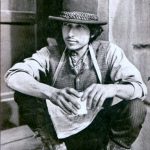 Other than ‘Don’t Look Back,’ the only decent film that Dylan has ever been associated with is, in my humble estimation, Sam Peckinpah’s ‘Pat Garrett and Billy the Kid,’ 1973. I think this is a great movie and I’ve watched it and recommended it many times. Dylan plays a twitchy character named Alias who lurks around the periphery of the Kid’s gang, reading the names off of canned goods and occasionally throwing knives at people. The cast is excellent from stem to stern and Kris Kristofferson does a fine squinty job of portraying the Kid, despite being in his mid-‘30s at the time (the Kid died at the ripe old age of 21). Dylan provided the soundtrack for the film and that is somewhat of a mixed bag, but it does contain one certified Dylan classic, ‘Knockin’ On Heaven’s Door.’ If you have never seen this film, do yourself a favor. It’s a rock & roll film, 1880s/Lincoln County variety.
Other than ‘Don’t Look Back,’ the only decent film that Dylan has ever been associated with is, in my humble estimation, Sam Peckinpah’s ‘Pat Garrett and Billy the Kid,’ 1973. I think this is a great movie and I’ve watched it and recommended it many times. Dylan plays a twitchy character named Alias who lurks around the periphery of the Kid’s gang, reading the names off of canned goods and occasionally throwing knives at people. The cast is excellent from stem to stern and Kris Kristofferson does a fine squinty job of portraying the Kid, despite being in his mid-‘30s at the time (the Kid died at the ripe old age of 21). Dylan provided the soundtrack for the film and that is somewhat of a mixed bag, but it does contain one certified Dylan classic, ‘Knockin’ On Heaven’s Door.’ If you have never seen this film, do yourself a favor. It’s a rock & roll film, 1880s/Lincoln County variety.
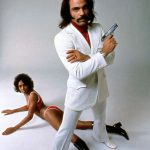 Blaxploitation films came into their own in the 1970s with standout hits like ‘Shaft,’ 1971, ‘Superfly,’ 1972 and the concert film ‘WattStax,’ 1973. These films were huge in New Orleans when I was a kid and Curtis Mayfield’s ‘Superfly’ soundtrack was ubiquitous—the album actually ended up out-grossing the film, which is a pretty neat trick. Issac Hayes won an Oscar for the ‘Shaft’ theme, but the film was ultimately more influential than the soundtrack. I’ll admit that I’ve never actually sat down and watched ‘Superfly,’ but the soundtrack is a regular presence in my Matador playlists.
Blaxploitation films came into their own in the 1970s with standout hits like ‘Shaft,’ 1971, ‘Superfly,’ 1972 and the concert film ‘WattStax,’ 1973. These films were huge in New Orleans when I was a kid and Curtis Mayfield’s ‘Superfly’ soundtrack was ubiquitous—the album actually ended up out-grossing the film, which is a pretty neat trick. Issac Hayes won an Oscar for the ‘Shaft’ theme, but the film was ultimately more influential than the soundtrack. I’ll admit that I’ve never actually sat down and watched ‘Superfly,’ but the soundtrack is a regular presence in my Matador playlists.
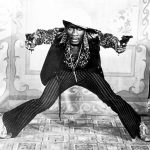 An iconic film that remains highly influential to this day is ‘The Harder They Come,’ 1972. This is one of those rare instances in which the film and the soundtrack are equally great. ‘The Harder They Come’ made a huge star out of Jimmy Cliff and introduced authentic roots reggae and ska to the world outside of the Caribbean. The success of the film and the soundtrack helped prime the scene for the emergence of Bob Marley, whose first album for Island Records was released the following year. The rest, as they say, is history, but the film and the music remain as vital and moving today as they were 46 years ago.
An iconic film that remains highly influential to this day is ‘The Harder They Come,’ 1972. This is one of those rare instances in which the film and the soundtrack are equally great. ‘The Harder They Come’ made a huge star out of Jimmy Cliff and introduced authentic roots reggae and ska to the world outside of the Caribbean. The success of the film and the soundtrack helped prime the scene for the emergence of Bob Marley, whose first album for Island Records was released the following year. The rest, as they say, is history, but the film and the music remain as vital and moving today as they were 46 years ago.
Now I guess it’s time to address ‘Saturday Night Fever,’ 1977. At the time this film was released rock and roll and disco were locked in a cultural death match—you were either on one side or the other and there was no room for compromise. I doubt that I have to suggest which side of this vast divide I myself was on. I danced at parties and in clubs all the time when I was kid, but to rock and funk music. I considered the disco scene with its mirror balls, feathered hairdos and polyester Angel Flight disco suits not only laughable but embarrassing and grotesque. As a result, I did not get around to watching ‘Saturday Night Fever’ until sometime in the mid to late 1990s. Well, knock me over with a disco feather, it’s actually a great film. John Travolta and the BeeGees were already stars but the film turned them into superstars and the movie and its soundtrack were massive critical and commercial successes. I was not then nor am I now a particular fan of Travolta or the BeeGees, but I have sincere appreciation for them both and for the extraordinary accomplishment of capturing cultural lightning in a bottle to the extent that they did.
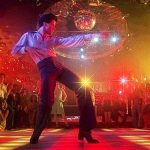 Odd thing about ‘Saturday Night Fever’—it’s based on a story by the title of ‘Tribal Rites of the New Saturday Night,’ published in New York Magazine in 1976. The author was the British journalist Nik Cohn. Cohn was friendly with Pete Townshend in London in the 1960s and his critical assessment of an early acetate of ‘Tommy’ inspired Townshend to write ‘Pinball Wizard’ (Cohn was a pinball enthusiast). The pinball theme became central to the ‘Tommy’ concept and gave rise to the album’s most popular track. In the 1990s Nik Cohn admitted that the New York Magazine story was a total fabrication and was, in fact, based upon his recollections of the Mod scene in 1960s London. Funny how things work out, ain’t it?
Odd thing about ‘Saturday Night Fever’—it’s based on a story by the title of ‘Tribal Rites of the New Saturday Night,’ published in New York Magazine in 1976. The author was the British journalist Nik Cohn. Cohn was friendly with Pete Townshend in London in the 1960s and his critical assessment of an early acetate of ‘Tommy’ inspired Townshend to write ‘Pinball Wizard’ (Cohn was a pinball enthusiast). The pinball theme became central to the ‘Tommy’ concept and gave rise to the album’s most popular track. In the 1990s Nik Cohn admitted that the New York Magazine story was a total fabrication and was, in fact, based upon his recollections of the Mod scene in 1960s London. Funny how things work out, ain’t it?
POP QUIZ: Name the BeeGees!!
Okay, let’s see—there’s Barry, he’s the one who looks like a lion, and there’s Maurice, the one who sort of looks like an accountant, and then there’s… wait… wait… uhhhhhh, DeeDee? No, that can’t be right… still thinking, still thinking… Jermaine?? No, sorry—different family… oh man, this is tough… Robin!! Yes!
 By the late ‘70s that cultural contagion known as ‘punk’ had reared up on both side of the Atlantic and, as with the first rock n’ roll revolution, the silver screen quickly got on board. I can’t say for certain who or what came first (after all, I wasn’t a punk before you weren’t a punk) but ‘Rock n’ Roll High School’ was released in 1979, followed shortly thereafter by ‘The Great Rock n’ Roll Swindle’ and ‘Rude Boy,’ both of 1980 and featuring, in order, the Ramones, the Sex Pistols and the Clash. None of these are great films by any stretch of the imagination, but ‘The Great Rock n’ Roll Swindle’ gets high marks for the sheer anarchic absurdity of Malcolm McLaren’s ‘cash from chaos’ philosophy. Johnny Rotten had left the Sex Pistols by the time filming started but he later teamed up with ‘Swindle’s’ director Julien Temple for ‘The Filth and the Fury,’ 2000, a worthy film that offers an alternate, less McLaren-centric, version of the Sex Pistols story.
By the late ‘70s that cultural contagion known as ‘punk’ had reared up on both side of the Atlantic and, as with the first rock n’ roll revolution, the silver screen quickly got on board. I can’t say for certain who or what came first (after all, I wasn’t a punk before you weren’t a punk) but ‘Rock n’ Roll High School’ was released in 1979, followed shortly thereafter by ‘The Great Rock n’ Roll Swindle’ and ‘Rude Boy,’ both of 1980 and featuring, in order, the Ramones, the Sex Pistols and the Clash. None of these are great films by any stretch of the imagination, but ‘The Great Rock n’ Roll Swindle’ gets high marks for the sheer anarchic absurdity of Malcolm McLaren’s ‘cash from chaos’ philosophy. Johnny Rotten had left the Sex Pistols by the time filming started but he later teamed up with ‘Swindle’s’ director Julien Temple for ‘The Filth and the Fury,’ 2000, a worthy film that offers an alternate, less McLaren-centric, version of the Sex Pistols story.
 1984 struck an interesting balance with ‘Purple Rain’ and ‘Repo Man,’ two notable films that were hits at different levels, and one of which made a global superstar out of Prince. ‘Purple Rain’ stars Prince as the Kid, a Minneapolis rock n’ soul musician who is rather oddly reminiscent of, well… Prince. Makes sense. If Prince had gone the Elvis route and portrayed a race car driver, a cowboy or a crop duster pilot it probably just wouldn’t have worked at all. As it is, I’d have to say that he’s not especially convincing at playing himself which makes for a rather uneven film. The performance sequences are great and Morris Day and the Time kind of steal the show. ‘Repo Man’ still holds up pretty well—it’s been on rotation at the Matador for many years and even with subtitles it’s a hoot. The soundtrack album is a strong collection of early ’80s punk and if you have any inclination towards nihilistic sci fi punk rock comedies this is very likely a film for you.
1984 struck an interesting balance with ‘Purple Rain’ and ‘Repo Man,’ two notable films that were hits at different levels, and one of which made a global superstar out of Prince. ‘Purple Rain’ stars Prince as the Kid, a Minneapolis rock n’ soul musician who is rather oddly reminiscent of, well… Prince. Makes sense. If Prince had gone the Elvis route and portrayed a race car driver, a cowboy or a crop duster pilot it probably just wouldn’t have worked at all. As it is, I’d have to say that he’s not especially convincing at playing himself which makes for a rather uneven film. The performance sequences are great and Morris Day and the Time kind of steal the show. ‘Repo Man’ still holds up pretty well—it’s been on rotation at the Matador for many years and even with subtitles it’s a hoot. The soundtrack album is a strong collection of early ’80s punk and if you have any inclination towards nihilistic sci fi punk rock comedies this is very likely a film for you.
 POP QUIZ #2: How many films mentioned in this series feature Harry Dean Stanton?
POP QUIZ #2: How many films mentioned in this series feature Harry Dean Stanton?
All of them?? Hell, I don’t know. He was probably one of the dancers in the ‘T.A.M.I. Show’ and I wouldn’t be surprised if he’s somewhere in the crowd at ‘Monterey Pop’ or lurking around the Ricky Tick Club in ‘Blow-Up.’ Let me know if you figure it out.
 Another cinematic notable of 1984 was ‘This Is Spinal Tap,’ the groundbreaking mockumentary that, taking its inspiration from films such as ‘A Hard Day’s Night’ and ‘Don’t Look Back,’ goes on to send up a whole raft of rock & roll cliches ranging from the volatility of drummers to obsessive guitar collecting to ‘turning it up to 11.’ The deadpan observational style of ‘Spinal Tap’ was sufficiently effective and influential to create genuine confusion when the excellent and touching film ‘Anvil! The Story of Anvil’ was released 25 years later. Was ‘Anvil!’ real or was it a further excursion down the ‘Spinal Tap’ rabbit hole? Having sold enough Anvil albums during my record store career in the 1980’s I knew perfectly well that the band was real, but the group’s assorted misadventures seemed absurd enough to stretch credulity. The fact that Anvil’s drummer was named Robb Reiner seemed suspicious (‘Spinal Tap’ having been directed by Rob Reiner) but ‘Anvil! The Story of Anvil’ was the real deal and one of the better rock documentaries of recent years.
Another cinematic notable of 1984 was ‘This Is Spinal Tap,’ the groundbreaking mockumentary that, taking its inspiration from films such as ‘A Hard Day’s Night’ and ‘Don’t Look Back,’ goes on to send up a whole raft of rock & roll cliches ranging from the volatility of drummers to obsessive guitar collecting to ‘turning it up to 11.’ The deadpan observational style of ‘Spinal Tap’ was sufficiently effective and influential to create genuine confusion when the excellent and touching film ‘Anvil! The Story of Anvil’ was released 25 years later. Was ‘Anvil!’ real or was it a further excursion down the ‘Spinal Tap’ rabbit hole? Having sold enough Anvil albums during my record store career in the 1980’s I knew perfectly well that the band was real, but the group’s assorted misadventures seemed absurd enough to stretch credulity. The fact that Anvil’s drummer was named Robb Reiner seemed suspicious (‘Spinal Tap’ having been directed by Rob Reiner) but ‘Anvil! The Story of Anvil’ was the real deal and one of the better rock documentaries of recent years.
 ‘Sid and Nancy,’ directed by Alex Cox of ‘Repo Man’ fame, was released in 1986 and is notable as the first cinematic hagiography of an iconic punk musician. It’s been a long time since I saw it but I recall it as an effective but ugly film about an ugly subject—the toxic relationship between Sid Vicious and Nancy Spungen. It was generally well considered at the time but I wasn’t overly impressed and John Lydon, né Rotten, slammed the film in his autobiography. When asked if he thought that Cox had gotten anything right, Lydon responded ‘Maybe the name Sid.’ I’ll take Mr. Lydon’s word on that.
‘Sid and Nancy,’ directed by Alex Cox of ‘Repo Man’ fame, was released in 1986 and is notable as the first cinematic hagiography of an iconic punk musician. It’s been a long time since I saw it but I recall it as an effective but ugly film about an ugly subject—the toxic relationship between Sid Vicious and Nancy Spungen. It was generally well considered at the time but I wasn’t overly impressed and John Lydon, né Rotten, slammed the film in his autobiography. When asked if he thought that Cox had gotten anything right, Lydon responded ‘Maybe the name Sid.’ I’ll take Mr. Lydon’s word on that.
Interestingly, a certain Courtney Love had a minor role in ‘Sid and Nancy,’ and, as well all now know, she would later become a leading player in another high profile toxic relationship—specifically hers with Nirvana’s genius frontman Kurt Cobain. Nick Broomfield’s documentary ‘Kurt and Courtney,’ 1998, was controversial from the beginning due in part to Love’s efforts to suppress the film. Depending on whose narrative you chose to believe, Courtney Love was either the supportive wife, muse, and grieving widow or an abusive, evil, manipulative murderer/co-conspirator. I’ve never had the dubious pleasure of making Ms. Love’s acquaintance so my impressions are third or fourth-hand at best, but everybody loves a good conspiracy theory and Broomfield delivers the smarmy goods. As pretty much nobody in the picture seems like a particularly reliable narrator it’s up to the individual viewer to figure it all out. I wonder what Alex Jones’ thoughts on the matter are?
The time honored live fast/die young rock star narrative continues to fascinate and the all-too-brief life of Kurt Cobain is no exception. Cobain has provided the grist for numerous cinematic offerings of both the documentary and dramatic varieties, including Gus Van Zandt’s ‘Last Days,’ 2005, ‘Kurt Cobain: Montage of Heck,’ 2015, ‘Soaked in Bleach,’ 2015, and ‘Cobain,’ a new Danish offering of this very Year of Our Lord, 2018.
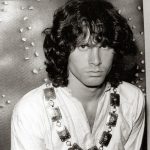 Long before poor Kurt’s premature merger with eternity there was the man who provided the modern template for the tragic rock star role, Jim Morrison. ‘The Doors,’ released in 1991, gave us Oliver Stone’s take on the life and legend of the Lizard King. Oliver Stone is a blowhard and a bullshit merchant of the very first water and while I consider this film to be a load of bollocks from start to finish I must admit that it does manage to cough up a few poetic moments. Most problematically, Val Kilmer is a pretty feeble substitute for Jim Morrison, but then who wouldn’t be? If you can’t really buy into the lead character in a film the rest of it just doesn’t stand much of a chance. There’s enough high quality footage of the Doors out there now that there’s no need to subject yourself to watching Kilmer pretend to be Stone’s fantasy version of Morrison. Regarding Stone’s fantasy version of things, check out the Wikipedia page on the ‘The Doors’: The longest section on the page is the listing of historical inaccuracies in the film. The antidote to all this unpleasantness is the excellent documentary ‘When You’re Strange,’ 2009—a film that Ray Manzarek endorsed, saying that it was ‘the anti-Oliver Stone.’ If it’s good enough for Ray it’s good enough for me.
Long before poor Kurt’s premature merger with eternity there was the man who provided the modern template for the tragic rock star role, Jim Morrison. ‘The Doors,’ released in 1991, gave us Oliver Stone’s take on the life and legend of the Lizard King. Oliver Stone is a blowhard and a bullshit merchant of the very first water and while I consider this film to be a load of bollocks from start to finish I must admit that it does manage to cough up a few poetic moments. Most problematically, Val Kilmer is a pretty feeble substitute for Jim Morrison, but then who wouldn’t be? If you can’t really buy into the lead character in a film the rest of it just doesn’t stand much of a chance. There’s enough high quality footage of the Doors out there now that there’s no need to subject yourself to watching Kilmer pretend to be Stone’s fantasy version of Morrison. Regarding Stone’s fantasy version of things, check out the Wikipedia page on the ‘The Doors’: The longest section on the page is the listing of historical inaccuracies in the film. The antidote to all this unpleasantness is the excellent documentary ‘When You’re Strange,’ 2009—a film that Ray Manzarek endorsed, saying that it was ‘the anti-Oliver Stone.’ If it’s good enough for Ray it’s good enough for me.
 In 1994 Peter Gabriel, one of the most sonically and visually adventurous artists of the 1980s and ‘90s, released ‘Secret World Live,’ a concert documentary filmed over the course of two shows in Modena, Italy. This is one of my all-time favorite concert films and I’ve watched it more times than I can possibly recall. The band is fantastic, featuring Gabriel stalwarts Tony Levin on bass, David Rhodes on guitar and Manu Katche on drums, augmented by keyboardist Jean-Claude Naimro, Shankar on electric violin and the amazing Paula Cole on vocals. Everybody shines in this film but if anyone comes close to stealing the show it’s Cole. She has a powerhouse voice and, well, she’s just absolutely lovely as well.
In 1994 Peter Gabriel, one of the most sonically and visually adventurous artists of the 1980s and ‘90s, released ‘Secret World Live,’ a concert documentary filmed over the course of two shows in Modena, Italy. This is one of my all-time favorite concert films and I’ve watched it more times than I can possibly recall. The band is fantastic, featuring Gabriel stalwarts Tony Levin on bass, David Rhodes on guitar and Manu Katche on drums, augmented by keyboardist Jean-Claude Naimro, Shankar on electric violin and the amazing Paula Cole on vocals. Everybody shines in this film but if anyone comes close to stealing the show it’s Cole. She has a powerhouse voice and, well, she’s just absolutely lovely as well.
The staging of the concert was designed by Robert Lepage, who went on to design and direct a groundbreaking production of Wagner’s ‘Ring Cycle’ for the Metropolitan Opera. ‘Secret World Live’ was one of the most ambitious concert presentations of its day, incorporating an elaborate stage set featuring a giant revolving video screen, a moving walkway, a huge dome and a variety of other innovative effects. The two performances were seamlessly edited together so that the production crew is nigh on invisible—there are almost no stage hands scurrying about and no camera operators appear anywhere in the film. The concert is centered around songs from Gabriel’s 1992 album ‘Us’ and its predecessor ‘So’—in other words, his very best work. The songs range from dark to upbeat and danceable, but the overall vibe is irresistibly uplifting. The closing song, ‘In Your Eyes‘ featuring Papa Wemba and his band, is as moving as any concert sequence I’ve ever experienced. Please, do yourself a favor—click on the link and watch it now. As with ‘A Hard Day’s Night,’ anyone who can’t appreciate the joy in this film should be regarded as highly suspect.
Gabriel followed up ‘Secret World Live’ with a string of adventurous concert documents (‘Growing Up, Live,’ 2003, ‘Still Growing Up: Live & Unwrapped,’ 2005, ’New Blood,’ 2011,’ ‘Live in Athens,’ 2013, ‘Back to Front,’ 2014), all of which I can recommend as being worthy, but none of which is as much of an unreserved pleasure as ‘Secret World Live.’
 A nice complement to ‘Secret World Live’ is another concert film that incorporates a variety of world music elements—‘Jimmy Page & Robert Plant: No Quarter/Unledded.’ Led Zeppelin’s prior cinematic legacy consisted solely of the mediocre ‘The Song Remains the Same,’ and while this isn’t quite a Zeppelin reunion (John Bonham was, of course, deceased and John Paul Jones wasn’t invited to participate) it’s a damn fine offering nonetheless. The film was shot at a soundstage in London and on location in Marrakech and Wales. Page and Plant perform variously as an acoustic duo, with a five-piece rock ensemble, and accompanied by an 11-piece Egyptian string and percussion ensemble, a 29-piece classical string orchestra, and a traditional Moroccan folk quartet. Page and Plant were both in top form for ‘No Quarter/Unledded,’ finally putting to rest the concerns about Page’s abilities as a guitarist that had been rife after a series of dreadful one-off performances during the 1980s and early ‘90s. P+P deserve huge props for stretching themselves musically and not resting on their laurels with this project.
A nice complement to ‘Secret World Live’ is another concert film that incorporates a variety of world music elements—‘Jimmy Page & Robert Plant: No Quarter/Unledded.’ Led Zeppelin’s prior cinematic legacy consisted solely of the mediocre ‘The Song Remains the Same,’ and while this isn’t quite a Zeppelin reunion (John Bonham was, of course, deceased and John Paul Jones wasn’t invited to participate) it’s a damn fine offering nonetheless. The film was shot at a soundstage in London and on location in Marrakech and Wales. Page and Plant perform variously as an acoustic duo, with a five-piece rock ensemble, and accompanied by an 11-piece Egyptian string and percussion ensemble, a 29-piece classical string orchestra, and a traditional Moroccan folk quartet. Page and Plant were both in top form for ‘No Quarter/Unledded,’ finally putting to rest the concerns about Page’s abilities as a guitarist that had been rife after a series of dreadful one-off performances during the 1980s and early ‘90s. P+P deserve huge props for stretching themselves musically and not resting on their laurels with this project.
 Page and Plant eventually returned to a more traditional Zeppelin mode with their true reunion concert document ‘Celebration Day,’ 2012. The film was shot in 2007 at the O2 Arena in London as a benefit/tribute concert to commemorate the legendary music exec Ahmet Ertegun. Weirdly, Ertegun’s death was the result of a brain injury suffered in a fall backstage at the Beacon Theater in New York on the night the Rolling Stones were being filmed for Martin Scorsese’s ‘Shine A Light’—another reason not to like that movie. The O2 Arena concert thankfully brought John Paul Jones back into the fold and featured John Bonham’s son Jason filling in very ably indeed on the skins. Visually and musically this film is excellent and finally provides a worthy coda to the Zeppelin legacy, especially as future Page/Plant/Jones collaborations look increasingly unlikely.
Page and Plant eventually returned to a more traditional Zeppelin mode with their true reunion concert document ‘Celebration Day,’ 2012. The film was shot in 2007 at the O2 Arena in London as a benefit/tribute concert to commemorate the legendary music exec Ahmet Ertegun. Weirdly, Ertegun’s death was the result of a brain injury suffered in a fall backstage at the Beacon Theater in New York on the night the Rolling Stones were being filmed for Martin Scorsese’s ‘Shine A Light’—another reason not to like that movie. The O2 Arena concert thankfully brought John Paul Jones back into the fold and featured John Bonham’s son Jason filling in very ably indeed on the skins. Visually and musically this film is excellent and finally provides a worthy coda to the Zeppelin legacy, especially as future Page/Plant/Jones collaborations look increasingly unlikely.
 While we’re on the subject of Brit blues rockers, Cream had a brief lifespan of just over two years before their volatile union blew apart in November, 1968. Their swan song at Royal Albert Hall was filmed for posterity and a pretty dismal affair it was indeed—bad sound, even worse camera work, and the performance itself was far from their best. I saw the film only once, at a midnight movie showing back in the ‘70s, and I’ve never felt compelled to watch it again. Thankfully, the boys in the band—Eric Clapton, Ginger Baker and Jack Bruce—survived, relatively intact, into the next century and in May, 2005, they gathered once again at the Royal Albert to grace us with the benefit of their musical wisdom. ‘Cream: Royal Albert Hall’ is pretty much everything one might hope for: beautifully filmed, great sound, and the band is fantastic.
While we’re on the subject of Brit blues rockers, Cream had a brief lifespan of just over two years before their volatile union blew apart in November, 1968. Their swan song at Royal Albert Hall was filmed for posterity and a pretty dismal affair it was indeed—bad sound, even worse camera work, and the performance itself was far from their best. I saw the film only once, at a midnight movie showing back in the ‘70s, and I’ve never felt compelled to watch it again. Thankfully, the boys in the band—Eric Clapton, Ginger Baker and Jack Bruce—survived, relatively intact, into the next century and in May, 2005, they gathered once again at the Royal Albert to grace us with the benefit of their musical wisdom. ‘Cream: Royal Albert Hall’ is pretty much everything one might hope for: beautifully filmed, great sound, and the band is fantastic.
I have made the case (to the very few willing to listen) that Cream was a better band in 2005 than they were in the ‘60s: Less inclined to overplay, more inclined to listen to one another, and very likely better overall musicians than they were 37 years earlier. Not all of it is spellbinding, but the performances of ‘Sleepy Time Time,’ ‘Stormy Monday’ and ‘Toad’ alone are worth the price of admission. Very few truly significant bands of the ‘60s made it this far with their membership fully intact and it seemed like a real gift to have this document to cement the legitimacy of Cream’s considerable reputation. Ginger Baker’s maniacal legend is well served in the wild documentary ‘Beware of Mr. Baker,’ 2012—the rare film in which its subject is captured committing assault and battery on the filmmaker. There’s a new Clapton biographical document—’Eric Clapton: Life in 12 Bars’—that I have heard good things about but have yet to see, and there’s an odd little film about Jack Bruce titled ‘Rope Ladder to the Moon’ that you can watch by clicking here.
As we stumbled our collective way into the new millennium a critically acclaimed Chicago band was in the process of working on their fourth studio album while dealing with creative differences within the group and intransigence from their record company. The band was Wilco, the album was ‘Yankee Hotel Foxtrot,’ and the record company was Reprise (a division of the Warner Music Group). A first-time filmmaker named Sam Jones happened to be documenting the moment. The film is ‘I Am Trying To Break Your Heart: A Film About Wilco,’ and it is an early and very worthy entry in a new era of alternative/indie filmmaking about alternate/indie music (not that Wilco, being affiliated with the Warner conglomerate, was exactly ‘indie’).
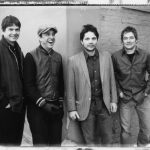 If Sam Jones had made ‘I Am Trying to Break Your Heart’ under normal circumstances it probably would have been required watching for dedicated Wilco fans and a mild diversion for anyone else. As it happened, Jones caught the band as it was beset by both internal and external conflicts concerning its future direction. The band’s founding drummer, Ken Coomer, was given the boot just as filming began, and the film captures Jeff Tweedy and multi-instrumentalist Jay Bennett knocking heads in the studio. The band’s manager wrangles on the phone with the suits at Reprise and, concerned that the new album lacks commercial appeal, the company cuts the band loose, allowing them to walk away with their new album in hand. In short order, Wilco is signed to the Nonesuch label, also part of the Warner conglomerate, and they get paid twice for the same album. The tensions between Tweedy and Bennett result in Bennett being shown the door.
If Sam Jones had made ‘I Am Trying to Break Your Heart’ under normal circumstances it probably would have been required watching for dedicated Wilco fans and a mild diversion for anyone else. As it happened, Jones caught the band as it was beset by both internal and external conflicts concerning its future direction. The band’s founding drummer, Ken Coomer, was given the boot just as filming began, and the film captures Jeff Tweedy and multi-instrumentalist Jay Bennett knocking heads in the studio. The band’s manager wrangles on the phone with the suits at Reprise and, concerned that the new album lacks commercial appeal, the company cuts the band loose, allowing them to walk away with their new album in hand. In short order, Wilco is signed to the Nonesuch label, also part of the Warner conglomerate, and they get paid twice for the same album. The tensions between Tweedy and Bennett result in Bennett being shown the door.
Jones’s film captures both the drama and the quiet moments, band performances, recording and mixing sessions and the migraine-prone Tweedy barfing in a toilet, all in lustrous black and white. The opening sequence of Tweedy driving in the rain along Lakeshore Drive while his solo acoustic rendering of the title song plays in the background is pure poetry. ‘Yankee Hotel Foxtrot’ went on to become a major commercial and critical triumph and Wilco became one of the most important American bands of the 2000s. Whether or not you know or care much about Wilco, if you appreciate a good documentary this film is well worth the effort. If you get the bug, ‘Sunken Treasure: Live in the Pacific Northwest‘ is a fine document of Jeff Tweedy onstage with only an acoustic guitar and a harmonica to defend himself. Tweedy’s freak-out at an inattentive audience right before performing ‘The Thanks I Get’ is a blast.
Now that just about anybody can make a film using an iPhone or a decent consumer-grade digital camera and basic editing software it has become next to impossible, if at all desirable, to keep abreast of the flood of music/concert films. Hardly a week goes by, it seems, when a new band/artist biopic or tour documentary doesn’t pop up on Netflix or HBO or Hulu or YouTube or somewhere in the boundless digiverse. But worthy contenders continue to appear and in recent years I’ve watched good to excellent documentaries about Lemmy, Daniel Johnston, Roky Erickson, the Drive By Truckers, the Dandy Warhols and the Brian Jonestown Massacre, the Beastie Boys, Metallica, Joy Division, Arthur Kane, Kathleen Hanna, Rodriguez, Iggy Pop, Gram Parsons, the Ramones, the Minutemen, the Jam, Lou Reed, Robin Hitchcock, the Germs, James Booker, George Harrison, Michael Jackson, Amy Winehouse, Nina Simone, Townes Van Zandt and probably a dozen others that I’ve forgotten about. It’s apparently a growth industry.
In some cases the motivation behind the project can be questionable. For instance, the Netflix film ‘Keith Richards: Under the Influence,’ contained some great archival footage that I’d never seen before but it was a pretty transparent shill for Richards’ new solo album. Beware any alleged documentary project that is too closely coordinated with the release of associated commercial product. ‘The Other One: The Long Strange Trip of Bob Weir,’ another Netflix production, offers an impressively in-depth look at its subject but manages to strategically omit the fact that Weir was sacked from the Grateful Dead for a period of months back in 1968 for being a slackass. An honest mistake, I’m sure.
‘It Might Get Loud,’ 2009, was a rather overly stagey and reverential look at the electric guitar’s dominance of rock & roll and the varied styles and techniques of Jimmy Page, the Edge and Jack White. The (not entirely surprising) upshot of this project is that Jimmy Page is a god, Jack White is a rather pretentious jerk, and the Edge has built a major career out of making something big out of very little. For me, the best parts of the film were the DVD extras where Jimmy Page shows the awestruck kids some of the tricks of his trade. But then I’m a bit prejudiced on this particular topic.
 One of the more inventive and compelling rock films of recent vintage is ‘20,000 Days On Earth,’ 2014, directed and written by Iain Forsythe and Jane Pollard. The conceit of the film is to track (very loosely) the progress of 24 hours in the life of Nick Cave. Nick wakes up in the morning, types (on a manual typewriter) in his office, works on songs for the album ‘Push the Sky Away’ with the Bad Seeds, talks with his psychiatrist, visits his archivists, has eels and pasta for lunch with Warren Ellis, and drives around Brighton in his car having conversations—either real or imaginary—with Blixa Bargeld, Ray Winstone and Kylie Minogue. This is a subtle and beautifully made film and it skillfully blurs the line between documentary and dramatic offering, challenging the viewer to suss out which one is which. More than your typical portrait of the artist, the film delves into the mysteries of the creative process and the manner in which Cave’s past and present inform his songwriting. Having been a borderline fan of Nick Cave for decades, this film was the catalyst for my becoming a full-fledged devotee. ‘20,000 Days on Earth’ stands alone as an excellent cinematic effort but it could also be key to opening one up to a wealth of fantastic music from Cave’s 40-plus year career—I recommend it wholeheartedly.
One of the more inventive and compelling rock films of recent vintage is ‘20,000 Days On Earth,’ 2014, directed and written by Iain Forsythe and Jane Pollard. The conceit of the film is to track (very loosely) the progress of 24 hours in the life of Nick Cave. Nick wakes up in the morning, types (on a manual typewriter) in his office, works on songs for the album ‘Push the Sky Away’ with the Bad Seeds, talks with his psychiatrist, visits his archivists, has eels and pasta for lunch with Warren Ellis, and drives around Brighton in his car having conversations—either real or imaginary—with Blixa Bargeld, Ray Winstone and Kylie Minogue. This is a subtle and beautifully made film and it skillfully blurs the line between documentary and dramatic offering, challenging the viewer to suss out which one is which. More than your typical portrait of the artist, the film delves into the mysteries of the creative process and the manner in which Cave’s past and present inform his songwriting. Having been a borderline fan of Nick Cave for decades, this film was the catalyst for my becoming a full-fledged devotee. ‘20,000 Days on Earth’ stands alone as an excellent cinematic effort but it could also be key to opening one up to a wealth of fantastic music from Cave’s 40-plus year career—I recommend it wholeheartedly.
As we draw to a close, I refer back to the introductory remarks courtesy of Frank Zappa. Despite his critical condescension, the man himself was involved in a couple of film projects of marginal coherence and artistic merit: the Monkees vehicle ‘Head’ (1968) and ‘200 Motels,’ (1971). Both films are of interest as oddball period pieces but have been relegated to the nether regions of rock-related cinematic history with good reason. So there.
Well, Gentle Reader(s), for better or worse, that’s about all I can summon forth on this particular topic. One of the best things about delving into this sort of thing nowadays is that most, if not all, of the material discussed herein is available to one and all with a few clicks and key taps via the miracle of the intrawebs. Happy viewing and keep those cards and letters coming in.
And as a reward for your perseverance here is another installment of Ye Olde Matador Playliste. Enjoy!
Matador Playlist 7/5/18
Grammar of Life – Charles Bukowski
All You Rock n’ Rollers – Ghostland Observatory
NY Is Killing Me – Gil Scott-Heron
Torqay – the Fireballs
Come Around – Doctor Bison
Bye Bye Love – the Everly Brothers
Gucci Coochie (feat. Dita Von Teese) – Die Antwoord
Nervis (feat. Cyril & Ivan Neville) – Trombone Shorty
Close Up the Honky Tonks – the Flying Burrito Brothers
Blue Blood Blues – the Dead Weather
Burn In Hell – Two Cow Garage
Everything Is Everything – Lauryn Hill (for Kirstiann)
Let’s Stop Kicking Our Hearts Around – Bottle Rockets
I Can’t Stand Up for Falling Down – Elvis Costello & the Attractions
Birthday – the Beatles
Nelson Mandela – Sonic & Taste T
(The Angels Wanna Wear My) Red Shoes – Elvis Costello & the Attractions
A New England – Billy Bragg (duet w/ Bruv Cubbie)
Whine and Grine/Stand Down Margaret – the English Beat
With A Girl Like You – the Troggs
Sinnerman (Felix da Housecat remix) – Nina Simone
S.O.B. – Nathaniel Rateliff & the Night Sweats (for Bruv Cubbie)
Seven Nation Army – the White Stripes
Finally Friday – George Jones
Alison – Elvis Costello & the Attractions
Strange Fruit (Tricky/Tool remix) – Billie Holiday
Shake Some Action – the Flaming Groovies
Bizarre Love Triangle – New Order
Loaded Heart – Gore Gore Girls
You Never Can Tell – Chuck Berry
Ooh Las Vegas – Gram Parsons
Summer Wind – Frank Sinatra
Crap Rap 2/Like to Blow – the Fall
Daft Punk is Playing at My House – LCD Soundsystem
Suspicious Minds – Elvis Presley
Mississippi Mud – Hank Williams III
Change the Locks – Lucinda Williams
Sex & Drugs & Rock & Roll – Ian Dury & the Blockheads
El Paso – Deadbolt
Message of Love – Jimi Hendrix/Band of Gypsies
Too Much Pork for Just One Fork – Southern Culture on the Skids
Viceroy’s Row – Elvis Costello & the Roots
Tupelo – Nick Cave & the Bad Seeds
Petition the Lord with Prayer – the Doors
Dead Cats, Dead Rats – the Doors
Doo Wop (That Thing) – Lauryn Hill
Manteca (Funky Lowlives remix) – Dizzy Gillespie
Roadhouse Blues – the Doors
Surf Beat – Lobos Negros
John Wayne Was A Nazi – M.D.C.
I Wanna Be Sedated – the Ramones
On the Corner – the Twilight Singers
Tinker, Tailor, Soldier, Sailor – the Yardbirds
The Rover – Led Zeppelin
I Wish I Knew How It Would Feel to be Free – Nina Simone
Pablo Picasso – Modern Lovers
Many Rivers to Cross – Jimmy Cliff
World Without Tears – Lucinda Williams
Buona Sera – Louis Prima
Happy Trails – Roy Rogers & Dale Evans (feat. Trigger on Supreme Courtiphone)
Taxi – Bryan Ferry

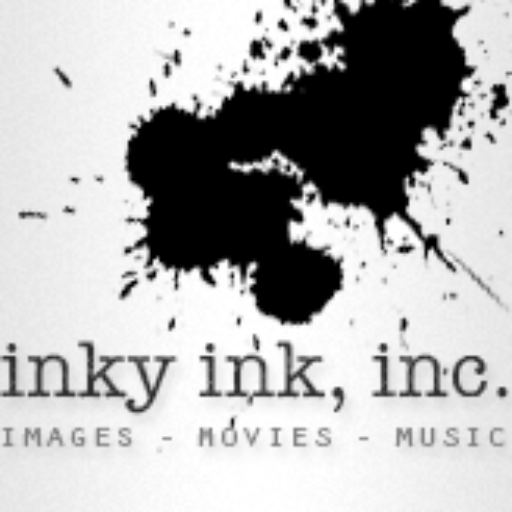
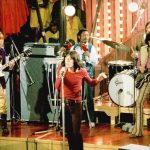
Sorry, the comment form is closed at this time.